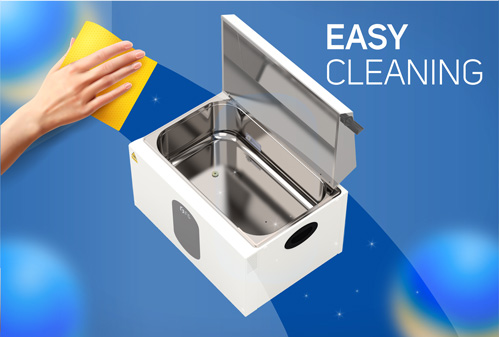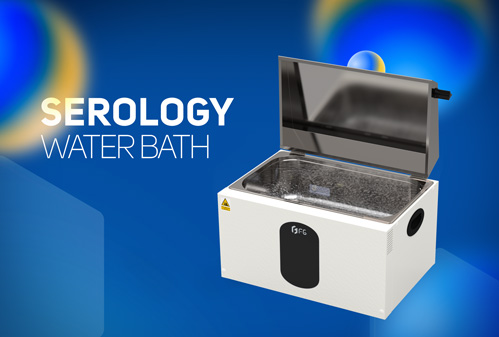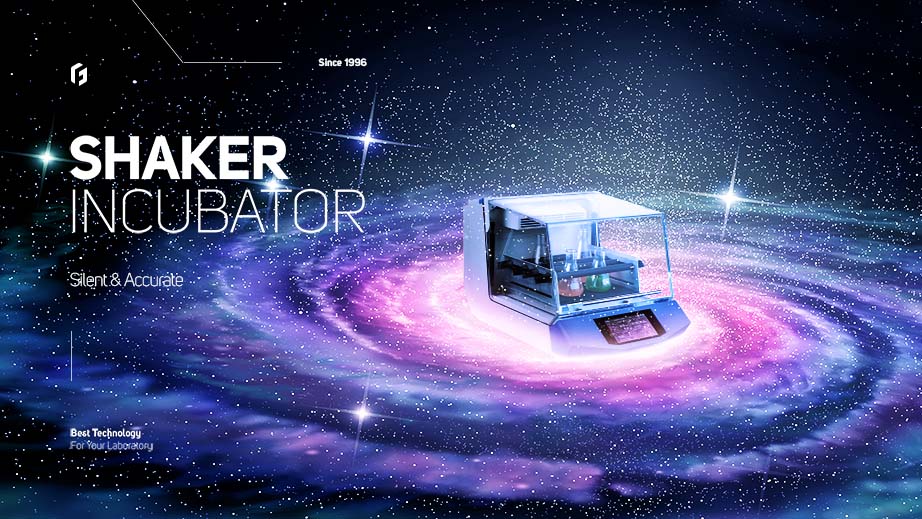

Boiling & Serology Water Bath
The FG Boiling & Serology Water Bath is a smart Water Bath that equipped with a PID Controller, known for its high precision and double-walled body. Special features such as placing the heating element outside the water tank, ensuring no contact with water (increasing the lifespan of the heating element), and using a seamless and welded water tank (for ease of cleaning) are among the advantages of this device. These features make it a high-quality and unmatched product.


Introduction of laboratory Water Bath
A Bain-Marie (or water bath) is a device used to create specific and stable temperatures in laboratories. Typically, it consists of a stainless steel basin filled with water. Various laboratory vessels are placed inside this basin to achieve the desired temperature for experiments and chemical reactions.
A laboratory Bain-Marie creates a warm water bath, allowing experiments requiring different temperatures to be conducted. The device features temperature control and a thermostat to measure and regulate the water temperature.
It’s commonly used in serological tests, biochemical tests, pharmaceutical experiments, and other experiments requiring precise temperatures. The laboratory Bain-Marie is a vital tool in medical, research, food industry, and educational laboratories.
Components of a serological welding Bain-Marie include:
- Water bath: The main part of the Bain-Marie, made of stainless steel.
- Heating element: Used to heat the water in the Bain-Marie.
- Thermostat: Used to regulate the temperature of the Bain-Marie.
- Thermometer: Used to display the temperature inside the water bath.
- Lid: Used to prevent heat loss and steam from the water.
Applications of a laboratory Bain-Marie include:
- Heating and incubating serological samples
- Heating and melting substances
- Conducting various laboratory tests
- Maintaining the temperature of substances in long-term experiments
Advantages of using a laboratory Bain-Marie include:
- Uniform and gentle heating: Bain-Maries do not use direct flame heating, resulting in uniform and gentle heating, preventing damage to samples.
- Accuracy and adjustability: The temperature of Bain-Maries can be precisely adjusted and maintained throughout the experiment.
- Safety and reliability: Bain-Maries are safe and reliable devices that pose no risk to the user when used correctly.
Safety precautions when using a serological welding Bain-Marie in the laboratory include:
- Carefully read the manufacturer’s instructions before using the Bain-Marie.
- Use the Bain-Marie on a flat and level surface.
- Use the Bain-Marie in a well-ventilated area.
- Avoid placing flammable materials inside the Bain-Marie.
- Wear gloves and safety goggles when working with the Bain-Marie.
- Disconnect the Bain-Marie from the power source when cleaning it.
Boiling & Serology Water Bath
A Boiling and Serology Water Bath, a subtype of laboratory Bain-Marie, is used to create high temperatures, particularly boiling water temperature (which is approximately 100 degrees Celsius at atmospheric pressure), for serological tests and the detection of antibodies and antigens. This device operates similarly to a standard boiling water bath, but with the difference that it raises the temperature to a much higher and precise level to create suitable conditions for serological tests. This type of water bath generates a completely gradual and stable temperature, making it highly suitable for experiments requiring constant and precise temperatures. This feature makes it a reliable and accurate tool for laboratory tests. The use of a Boiling and Serology Water Bath for serological tests such as antibody and antigen assays is highly important because these tests require specific and precise temperatures to produce accurate and reliable results.
What is Serology Water Bath?
A Serology Bain-Marie is a laboratory equipment used to create a controlled and uniform heat environment for conducting serological reactions. This device is commonly employed to maintain and establish precise temperatures during experiments such as ELISA (Enzyme-Linked Immunosorbent Assay), agglutination tests, and other reactions that require temperature control.
The thermostat present in the Bain-Marie allows the temperature to be maintained at a specific degree. This feature is crucial because serological and biochemical reactions are highly sensitive to temperature, and temperature fluctuations can affect the test results.
A Serology Bain-Marie typically consists of a basin or container filled with water and a heating element that maintains the temperature of the water uniformly and steadily. Samples are placed in special containers inside or above the water to benefit from gentle and uniform heating.
The use of a Bain-Marie in serology laboratories is necessary because serological reactions require specific conditions in which antigens are bound to antibodies. This process may require precise temperature, controlled humidity, or specific timing for the reaction to occur correctly.
Features of a Serology Bain-Marie include:
- Independent safety thermostat to prevent device operation when water is depleted (dry protection)
- Double-walled body to reduce heat transfer to the outer body and ensure user safety
- Installation of the heating element outside the water tank and no contact between the element and water for extended lifespan
- Seamless and welded stainless steel water tank for easy cleaning
- Special design of the external body to occupy minimal laboratory space
- Temperature increase and sensor failure alarms
- Temperature stability and reproducibility
- Uniform temperature across different points
- Centralized fault detection
- PT100 sensor
- Accuracy of ±0.1°C
- PID controller
What is Boiling Water Bath?
The Boiling Water Bath is a key piece of equipment used for slowly heating and maintaining chemical substances and samples at a constant temperature. It consists of a water bath and a heating element, typically controlled by an adjustable thermostat to provide the required temperature for various experiments.
Applications of the Bain-Marie laboratory heating bath include:
- Incubation – providing precise and constant temperature for enzymatic reactions and microbiological activities.
- Heating culture media – in tissue culture or microbiology for easier use of gel-like culture media.
- Water jacketing – in some enzyme-linked immunosorbent assay (ELISA) devices or reactors to maintain temperature.
- Biochemical and serological tests – requiring specific and stable temperatures.
Features of the Bain-Marie heating bath include:
- Independent safety thermostat to prevent the device from operating when the water runs out (dry protection).
- Double-walled construction to reduce heat transfer to the external body and ensure user safety.
- Installation of the heating element outside the water tank and no direct contact with water for extended lifespan.
- Seamless and weld-free stainless steel water tank for easy cleaning.
- Special design of the external body to occupy minimal laboratory space.
- Uniform temperature across different points.
The difference between Boiling & Serology Water Bath
water baths are widely used equipment in various laboratories for heating and maintaining the temperature of substances and samples. They come in two types: serological and boiling, each with its own specific applications. In this section, we’ll explore the differences between these two types of Bain-Maries and provide guidance on selecting the appropriate device.
Serological Bain-Marie:
Temperature Range: The temperature of these Bain-Maries is usually adjustable between 5 to 100 degrees Celsius. Applications: Serological Bain-Maries are used for various purposes including incubation, cell culture, serological and immunological tests, heating culture media and reagents, thawing frozen materials, etc. Features: These Bain-Maries offer high temperature accuracy and can be used with sensitive and delicate samples. They typically come equipped with a timer and temperature control system. Boiling Bain-Marie:
Temperature Range: The temperature of these Bain-Maries can be adjusted up to 100 degrees Celsius. Applications: Boiling Bain-Maries are used for more general purposes such as heating laboratory vessels, melting materials, boiling water, etc. Features: These Bain-Maries are not as precise in temperature accuracy as serological ones and may not be suitable for working with sensitive samples. Key Considerations in Bain-Marie Selection:
Application: The first step in selecting a Bain-Marie is determining its intended use. Temperature Range: Pay attention to the temperature range required for your specific applications. Temperature Accuracy: If high temperature accuracy is needed, a serological Bain-Marie is a better choice. Capacity: Bain-Maries are available in different capacities to suit your needs. Features: Some Bain-Maries come with additional features such as a timer, water circulation system, digital temperature control, etc. Choosing the appropriate Bain-Marie depends on the type of application, required temperature range, temperature accuracy, capacity, and desired features.
Types of laboratory water bath include:
Various types of laboratory Bain-Marie units are utilized in different laboratory settings to meet various needs. Below are examples of different types of laboratory Bain-Marie units:
- Boiling Water Bath: One of the most common and well-known types of laboratory Bain-Marie. In this type, water is used as the heating fluid to create a warm bath for test samples. It has the capability to bring water to its boiling point and then gradually and steadily transfer the boiled water’s temperature to the test material.
- Circulating Water Bath: Also known as a warm and cold Bain-Marie, this type utilizes proper fluid circulation (e.g., water) to establish and maintain a constant temperature within a specific range. The term “circulating” is derived from the word “circulation,” indicating fluid flow. In this unit, a built-in circulating pump continuously circulates the fluid within the unit, ensuring uniform temperature distribution throughout the bath. This maintains the desired environmental temperature within a constant range. The applications of circulating water baths are extensive in laboratories and various industries, including temperature measurement device calibration, chemical material testing, scientific research, and tests associated with different industries.
- Shaking Water Bath: A specialized type of laboratory Bain-Marie used for both temperature elevation and simultaneous agitation and mixing of its contents. Particularly suitable for materials requiring mixing and agitation, especially during temperature elevation. Besides temperature regulation and maintenance, the shaking action facilitates uniform mixing of substances, making it a practical tool in laboratory experiments and research. The primary applications of shaking water baths are in chemical and biochemical experiments, as these experiments typically require material mixing and synthesis. Additionally, shaking water baths find usage in fields like pharmaceutical research and biology.
- Oil Bath: A type of laboratory Bain-Marie that employs oil as the heat transfer fluid. Compared to water, oil has a lower specific heat capacity, resulting in temperature changes occurring more rapidly. In this type of Bain-Marie, heat transfer speed is slower, but temperature changes occur quickly. Oil baths serve as useful tools in various fields such as biotechnology, medicine, pharmaceuticals, petroleum engineering, and other industries. Due to the rapid temperature changes and precision in environmental temperature control, oil baths are highly useful for experiments requiring specific and continuous temperatures.
- Tissue Bath: This device is used to create specific temperatures for histological and pathological experiments.
- Sand Bath: In this type of Bain-Marie, sand or sand-like materials are used as the heating medium. It is utilized for higher temperatures and specific experiments.
Each of these types of Bain-Marie units has its own characteristics and specific applications, selected based on various laboratory needs.
The price of Serology & Boiling Water Bath
The price of Serological Boiling Water Baths varies depending on their type and size. For purchasing or obtaining the price list of Serological Boiling Water Baths, please contact the sales department of FG.
FG Serology & Boiling Water Bath in all kinds of laboratories Medical Investigative Industrial is applicable.
Heater Free Tank
Placing the heating element outside the water reservoir prevents undesirable effects of water and mineral deposits on the element, thus increasing its lifespan.
General characteristics of Serology & Boiling Water Bath
- Internal chamber and sloped door made of stainless steel.
- Body material: Powder-coated electrostatically painted sheet metal.
- Capability to install a circular plate (available upon request).
- Digital display with touch controls.
- Rounded corners for easy cleaning.
- Wide operating range from ambient temperature to boiling.
- Perforated tray made of stainless steel.
- smart 999-hour timer.
- Drain valve.




Unique features of FG Serology Water Bath
Independent safety thermostat to prevent device operation when water runs out (dry protection).
Installation of an element outside the water tank and no contact between the element and water for extended lifespan (element free tank).
Double-walled body to reduce heat transfer to the outer body and ensure user safety.
Seamless and weld-free pressurized stainless steel water tank for easy cleaning.
Special design of the outer body to occupy minimal laboratory space.
Temperature increase and sensor failure alarms.
Temperature stability and renewability.
Uniform temperature distribution across different points.
Centralized fault diagnosis.
PT100 sensor.
±0.1 accuracy PID controller.
Unique features of FG boiling Water Bath
– Independent safety thermostat to prevent device operation when water runs out (dry protection).
– Installation of an element outside the water tank and no contact between the element and water for extended lifespan (element free tank).
– Double-walled body to reduce heat transfer to the outer body and ensure user safety.
– Seamless and weld-free pressurized stainless steel water tank for easy cleaning.
– Special design of the outer body to occupy minimal laboratory space.
– Uniform temperature distribution across different points.

Product video
To get to know More details of the product Watch the opposite video.
technical specification table of laboratory water bath


Customized equipment and services
Customization capability
Capability to be built in refrigerated type
Capability to install a shaking plate
Circular home plate
Provision of calibration certificate












